UPSC Daily Current Affairs: 23rd October 2024 | Current Affairs & Hindu Analysis: Daily, Weekly & Monthly PDF Download
GS3/Environment
India is building a cloud chamber as part of Mission Mausam
Source: Indian Polity
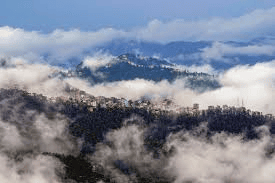
Why in news?
The Indian government has launched Mission Mausam, aimed at improving weather forecasting and managing weather events like rainfall, hail, fog, and possibly lightning strikes. A significant aspect of this mission involves cloud physics research, which is essential for effective weather modification. To facilitate this research, India is establishing its first cloud chamber at the Indian Institute of Tropical Meteorology (IITM) in Pune.
Cloud chamber under Mission Mausam
- India initiated Mission Mausam in September 2023 to enhance weather comprehension and forecasting.
- The mission will utilize expanded observation networks, improved modeling, and advanced technologies such as AI and machine learning.
- Nodal Ministry: Ministry of Earth Sciences (MoES)
Objective
- Improving Weather Prediction Accuracy: Mission Mausam seeks to enhance the accuracy and timeliness of weather and climate forecasts through advanced technologies.
- Strengthening Climate Resilience: The mission aims to empower various stakeholders, including citizens, to better manage extreme weather events and the impacts of climate change.
- Broadening Capacity in Weather Sciences: Through research and development, the mission intends to enhance India's capabilities in atmospheric sciences, including weather modeling, forecasting, and surveillance.
Focus area
- Monsoon Forecasts: Improved predictions for the monsoon season, which is vital for agriculture and water resource management.
- Air Quality Alerts: Providing precise forecasts regarding air quality to help manage pollution effectively.
- Extreme Weather Events: Timely warnings for cyclones, floods, and other severe weather conditions.
- Weather Interventions: Developing techniques to manage fog, hail, and rainfall to reduce disruptions in daily life and business operations.
Implementing Institutions
- India Meteorological Department (IMD): Responsible for issuing daily weather forecasts and warnings.
- Indian Institute of Tropical Meteorology (IITM): Focused on research related to tropical weather and climate.
- National Centre for Medium-Range Weather Forecasting (NCMRWF): Specializes in medium-range weather forecasting.
- Additional support will be provided by other MoES bodies, including the Indian National Centre for Ocean Information Services (INCOIS), National Centre for Polar and Ocean Research (NCPOR), and the National Institute of Ocean Technology (NIOT).
India's upcoming cloud chamber
- The facility at IITM Pune is designed to investigate Indian monsoon clouds.
- It will resemble a closed cylindrical drum that simulates conditions for cloud formation by injecting water vapor and aerosols while controlling humidity and temperature.
- Unlike basic cloud chambers around the world, India's facility will incorporate convection properties, which are essential for studying monsoon-related phenomena.
- This advanced setup will allow scientists to investigate the formation of cloud droplets or ice particles, with only a few similar convective cloud chambers available globally.
Why is India building a convective cloud chamber?
- Cloud physics involves the study of cloud behaviors, including particle interactions, rain droplet formation, and the effects of additional moisture from cyclones or low-pressure systems.
- Establishing this chamber aims to deepen the understanding of these processes under conditions relevant to Indian weather.
- The controlled environment will allow manipulation of parameters such as temperature, humidity, and convection to better comprehend monsoon cloud dynamics.
- This knowledge will aid in strategic planning for initiatives like the Cloud Aerosol Interaction and Precipitation Enhancement Experiment (CAIPEEX), which was a decade-long program focused on cloud seeding to boost rainfall.
- During the final phase (2016-2018), experiments conducted in the rain-shadow regions of Solapur, Maharashtra, demonstrated that suitable conditions for cloud seeding could lead to a rainfall increase of up to 46% in specific areas and around 18% in a 100 sq. km area downwind of the seeding site.
- Despite these findings, it’s recognized that cloud seeding alone cannot fully resolve rainfall challenges.
GS3/Science and Technology
Betelgeuse
Source: India Today

Why in News?
Recent research has unveiled a surprising discovery about Betelgeuse that the star's enigmatic brightening and dimming patterns may be caused by an unseen companion star.
About Betelgeuse:
- Betelgeuse is a red supergiant star located in the left shoulder of the constellation Orion.
- It ranks among the brightest stars visible in the night sky and is one of the largest stars ever identified.
- The star is situated approximately 650 light-years away from Earth.
- Betelgeuse is nearing the end of its life span; when it dies, its explosion will be bright enough to be seen during the day for several weeks.
- It is one of the largest known stars, with a diameter exceeding 700 million miles (1.2 billion kilometers).
- Betelgeuse is known for its periodic dimming and brightening.
- The star exhibits two distinct pulsation patterns: a shorter cycle lasting about a year and a longer cycle spanning approximately six years.
- Researchers concluded that the longer cycle, known as the long secondary period, is likely influenced by the orbital motion of a companion star, referred to as Betelbuddy, through the surrounding dust of Betelgeuse.
What is a Red Supergiant Star?
- A red supergiant is formed when a star exhausts its hydrogen fuel for nuclear fusion and begins the dying process.
- These stars are evolved entities with masses ranging from 10 to 25 times that of the Sun.
- A supergiant star can have a diameter several hundred times that of the Sun and a luminosity that can be nearly 1,000,000 times greater.
- Supergiants are tenuous and have lifetimes that are relatively short in the grand scheme of stellar evolution, typically lasting only a few million years.
- These stars feature cool, extended atmospheres.
GS3/Science and Technology
What is Cornea?
Source: The Hindu
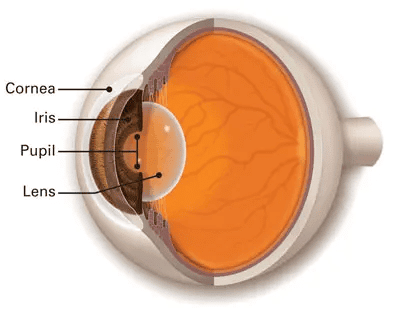
Why in News?
The Ministry of Health and Family Welfare may amend the Transplantation of Human Organs and Tissues Act (THOTA), 1994, to facilitate retrieval of cornea from all Indian patients who die in hospitals, without consent from the family.
About Cornea:
- The cornea is the clear outer layer located at the front of the eye.
- It serves to cover the pupil, which is the opening at the center of the eye, and the iris, the colored part of the eye, along with the anterior chamber, which is the fluid-filled space inside the eye.
- The primary function of the cornea is to refract or bend light, playing a crucial role in focusing most of the light that enters the eye.
- Its unique shape significantly impacts vision and helps filter out some ultraviolet (UV) rays.
- Aside from its edges, the cornea lacks blood vessels but is rich in nerve endings, making it very sensitive to pain and touch.
- Since the cornea does not possess blood vessels to supply nutrients, it relies on tears and the aqueous humor, a watery fluid in the anterior chamber, to receive nourishment.
- As light passes through the cornea, it is partially refracted prior to reaching the lens of the eye.
- The curvature of the cornea, which is spherical during infancy, changes with age and is responsible for its focusing ability.
- When the curvature becomes irregular, it leads to a visual defect known as astigmatism, where images may appear elongated or distorted.
- The cornea acts as the first line of defense for the eye's surface, making it susceptible to injuries and damage.
- Minor abrasions on the cornea tend to heal quickly, but deeper scratches can lead to scarring, which compromises the cornea's transparency and can cause visual impairment.
GS3/Science and Technology
Space Docking Experiment (SPADEX)
Source: The Week
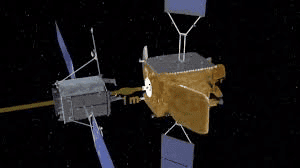
Why in News?
Recently, a Hyderabad-based company delivered two 400 kg class satellites to ISRO, which are intended for the upcoming Space Docking Experiment planned by the agency later this year.
About Space Docking Experiment (SPADEX):
- SPADEX represents a major advancement in ISRO's efforts to create autonomous docking technology.
- The mission consists of two vehicles known as the 'Chaser' and the 'Target' which will rendezvous and connect in outer space.
- Docking systems are crucial as they allow two spacecraft to join while in orbit, facilitating essential tasks such as:
- Assembling space stations
- Refueling spacecraft
- Transferring astronauts and cargo
- The experiment will assess how well the spacecraft maintain stability and control after they dock, which is vital for ensuring the reliability of future missions.
- India's SPADEX initiative is distinctive due to its focus on developing indigenous, scalable, and cost-efficient docking technologies.
- This experiment will involve autonomous docking of two spacecraft in orbit, showcasing essential capabilities in precision, navigation, and control that are critical for future missions.
- SPADEX aims to accommodate a variety of spacecraft sizes and mission goals, which includes potential partnerships for constructing space stations or exploring deeper into space.
History of Docking Systems:
- The inception of docking systems traces back to the Cold War, during which the Soviet Union accomplished the first successful docking in space.
- On October 30, 1967, the Soviet spacecraft Kosmos 186 and Kosmos 188 achieved the first fully automated docking between two unmanned vehicles, marking a milestone in space exploration.
- This historic event laid the groundwork for subsequent space missions, including the establishment of long-term human presence aboard space stations.
Significance:
- SPADEX is crucial for fulfilling India's long-term aspirations in space exploration, which encompass:
- Conducting manned spaceflights
- Maintaining satellites
- Constructing future space stations
GS3/Environment
Rajaji Tiger Reserve
Source: Tribune India

Why in news?
The wildlife panel of the Union Environment Ministry has postponed approval for the National Highway Authority of India’s (NHAI) four-lane project, which was intended to traverse both the Rajaji Tiger Reserve and the Shivalik Elephant Reserve located in Uttarakhand.
About Rajaji Tiger Reserve:
- Rajaji Tiger Reserve spans three districts: Haridwar, Dehradun, and Pauri Garhwal.
- It is situated in the Shivalik range of the Himalayas, covering an area of 820 square kilometers.
- The reserve is named after Rajgopalachari, a prominent figure in the Indian independence movement, commonly referred to as "Rajaji."
- It exists in a transition zone between the temperate western Himalayas and the central Himalayas, which boosts its biodiversity.
- Rajaji forms an integral part of the Terai-Arc landscape, which spans approximately 7500 kilometers.
- The reserve is bounded by the Yamuna River to the northwest and the Sharda River to the southeast.
Vegetation:
- The landscape features a mix of forest types, ranging from semi-evergreen to deciduous forests.
- It includes various ecosystems such as mixed broad-leaved forests and Terai grasslands.
- The area is categorized as part of the Indus-Ganges Monsoon Forest biome.
Flora:
- A variety of plant species can be found in the park, including Rohini, Palash, Shisham, Sal, Sandan, Khair, Arjun, Baans, Semul, and Chamaror.
Fauna:
- Rajaji Tiger Reserve is home to a significant population of Tigers and Asian Elephants.
- The reserve supports a diverse array of wildlife, including Leopards, Jungle Cats, Himalayan Black Bears, Sloth Bears, Striped Hyenas, Gorals, Sambars, Wild Pigs, Spotted Deer, and Barking Deer.
GS3/Environment
Biodiversity and Climate Change: COP16 and the Global Efforts to Address the Crisis
Source: World Economic Forum
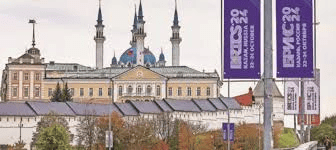
Why in news?
As the world confronts the dual challenges of climate change and biodiversity loss, international conferences like the UN Biodiversity Conference (COP16), set to take place in Cali, Colombia, have become increasingly significant. This event follows the Convention on Biological Diversity (CBD), which was initiated at the 1992 Rio Earth Summit. COP16 is dedicated to safeguarding biodiversity, rehabilitating ecosystems, and ensuring the equitable distribution of benefits derived from biological resources. This meeting is particularly important following the adoption of the Kunming-Montreal Global Biodiversity Framework in 2022, which established ambitious goals for biodiversity conservation by 2030.
Kunming-Montreal Global Biodiversity Framework:
- Finalized at COP15 in 2022, it sets out four main goals and 23 specific targets to be met by 2030.
- The prominent 30 x 30 target aims to conserve 30% of the world's land and oceans by 2030, focusing on areas rich in biodiversity.
- It also seeks to restore 30% of degraded terrestrial and marine ecosystems.
- Countries are required to submit their National Biodiversity Strategies and Action Plans (NBSAPs), similar to the Nationally Determined Contributions (NDCs) under the Paris Climate Agreement.
- As of now, only 32 countries have submitted their NBSAPs.
Interconnection Between Climate Change and Biodiversity:
- The relationship between climate change and biodiversity loss is profound, as climate change exacerbates the loss of biodiversity.
- Increased temperatures and erratic weather patterns lead to the destruction of ecosystems.
- Conversely, changes in ecosystems, such as deforestation and ocean warming, contribute to global warming.
- There is a growing recognition of the need to address these crises together rather than separately.
High Seas Treaty and Ocean Conservation:
- The finalization of the Biodiversity Beyond National Jurisdictions (BBNJ) treaty is a crucial development in combating biodiversity loss.
- This treaty aims to safeguard biodiversity in oceans beyond national jurisdictions.
- It advocates for the establishment of protected areas in biodiversity-rich ocean regions, enabling regulation of human activities similar to land-based national parks.
- The treaty also emphasizes the equitable sharing of benefits derived from genetic resources in the oceans, which have significant commercial value.
Access and Benefit Sharing: The Nagoya Protocol:
- Established at COP10 in 2010, this protocol lays out rules for Access and Benefit Sharing (ABS).
- It ensures that benefits from the commercial use of biological resources are fairly distributed to countries and communities that manage these resources.
- Discussions will involve sharing benefits from digital genetic information of plants and organisms, which are valuable for developing high-yield crops and medicines.
Financial Mechanisms for Biodiversity Conservation:
- Finance plays a crucial role in biodiversity negotiations, similar to climate change discussions.
- One of the targets is to mobilize $200 billion annually by 2030 from various sources for biodiversity conservation.
- This includes a commitment of $20 billion annually from developed to developing countries for biodiversity initiatives.
- There is a plan to increase this to $30 billion per year and to redirect harmful subsidies to sustainable practices.
Conclusion:
- As the world strives to tackle climate change and biodiversity loss, conferences like COP16 are vital for fostering international collaboration and action.
- The push for financial mobilization is essential in the global effort to conserve biodiversity.
- Both developed and developing countries must unite to realize these ambitious conservation goals.
GS3/Science and Technology
Clostridioides difficile bacteria
Source: Nature
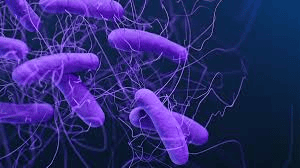
Why in News?
Researchers are making strides towards developing the first effective vaccine against the highly contagious and challenging-to-treat Clostridioides difficile bacteria. This vaccine utilizes the innovative mRNA technology that was pivotal in combating COVID-19.
About Clostridioides difficile bacteria:
- Clostridioides difficile is a bacterium responsible for infections in the colon, the longest segment of the large intestine.
- Symptoms of infection can vary widely, from mild diarrhea to severe complications that can be life-threatening.
- Infections often occur following antibiotic treatments, which disrupt the balance of bacteria in the gut.
- While it primarily impacts older adults in healthcare facilities and long-term care environments, individuals outside these settings can also contract the infection.
- Common symptoms include watery diarrhea accompanied by mild abdominal cramps and tenderness.
- Severe cases may lead to significant fluid loss, resulting in dehydration.
- A sudden and severe infection can cause the colon to become exceptionally inflamed and enlarged, a condition known as toxic megacolon.
Transmission:
- The bacterium can spread from one patient to another through the hands of healthcare workers.
- Approximately one-third of individuals who contract C. difficile will experience recurrent infections.
Treatment:
- Treatment typically involves an extended course of potent antibiotics, which may also eliminate beneficial gut bacteria.
- Another treatment option includes fecal transplants, which introduce healthy bacteria back into the gut.
GS1/Geography
Korowai Tribe
Source: Hindustan Times
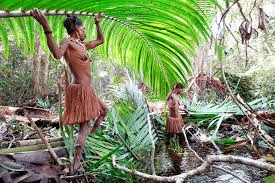
Why in News?
Recently, an Indian travel vlogger ventured deep into the jungles of Indonesia to meet the Korowai tribe, often sensationalized as a 'human-eating' tribe, and documented his experience on social media.
About Korowai Tribe:
- The Korowai tribe consists of indigenous individuals residing in the southeastern region of Papua, Indonesia.
- These people maintain a profound connection with the forest, which is essential for their survival, as they hunt and gather food from it, including various wild animals and edible plants.
- Until approximately 1975, the Korowai had minimal contact with outsiders, preserving their traditional way of life.
- They are well-known for constructing treehouses, which are typically built 8 to 15 meters above the ground, although some reach heights of up to 45 meters on taller trees.
- The tribe does not follow a strict hierarchy; instead, they emphasize principles of equality and harmony among their members.
- Modern media has sensationalized their culture due to their historical association with cannibalism, a practice of consuming human flesh.
- While it is believed that the tribe historically engaged in cannibalism as part of their cultural and spiritual beliefs, such practices have largely diminished over time.
GS2/International Relations
16th BRICS Summit in Russia
Source: Times of India

Why in news?
Prime Minister Narendra Modi is currently in Russia for the 16th BRICS Summit, along with Chinese President Xi Jinping and South African President Cyril Ramaphosa. The summit is hosted by Russian President Vladimir Putin in the city of Kazan.
- BRICS, originally consisting of five major emerging economies—Brazil, Russia, India, China, and South Africa—has evolved significantly.
- In 2023, during the 15th BRICS Summit held in South Africa, six new countries were invited to join the alliance: Iran, the United Arab Emirates, Saudi Arabia, Argentina, Egypt, and Ethiopia.
- Prior to this expansion, BRICS represented 42% of the world's population, 30% of the world's territory, 23% of global GDP, and around 18% of world trade.
- The alliance aims to counter the economic and political dominance of Western nations.
- BRICS holds annual summits where member states discuss priorities and strategies, taking turns in hosting these meetings.
Successes/achievements
- Economic Cooperation and Trade
- BRICS has promoted increased trade and investment among its member countries.
- There has been a notable rise in intra-BRICS trade, reinforcing economic ties.
- The group emphasizes reducing reliance on Western financial systems and enhancing economic resilience with inclusive growth models.
- New Development Bank (NDB)
- Established in 2014 with a capital of $100 billion, the NDB funds infrastructure and sustainable development projects within BRICS and other developing nations.
- The bank has financed various projects in member countries, focusing on renewable energy, urban development, and social infrastructure.
- Contingent Reserve Arrangement (CRA)
- The CRA, with a reserve pool of $100 billion, was established to provide financial support to members facing short-term liquidity issues.
- This arrangement serves as a safety net to protect member economies from external economic shocks.
- Political Influence and Multilateral Engagement
- BRICS has emerged as a significant political bloc, advocating for a multipolar world order and greater representation of developing countries in global institutions such as the United Nations, IMF, and World Bank.
- Technical Cooperation
- Mechanisms for cooperation in technology, science, and innovation have been established within BRICS.
- Initiatives like the BRICS Science, Technology, and Innovation Framework Programme aim to enhance collaboration in research and technical fields.
- Joint efforts in health, agriculture, and disaster management showcase the group's commitment to addressing global challenges.
Challenges Faced by BRICS
- Economic Disparities Among Members
- The BRICS nations exhibit significant economic diversity, with varying levels of development, economic structures, and political systems.
- This disparity occasionally obstructs consensus on key issues, as members' priorities and interests can differ greatly.
- Geopolitical Rivalries
- Geopolitical tensions, particularly between China and India, have sometimes strained relationships within BRICS, affecting the group's unity.
- Territorial disputes and regional interests can influence decision-making processes.
- Relationship with Western Powers
- The relationship between BRICS and Western nations is complex, with differing strategies among member countries.
- China and Russia are increasingly wary of the West, especially following the Russia-Ukraine War and tensions in US-China relations.
- In contrast, India has been strengthening its economic and technological ties with the US.
- Slow Progress on Institutional Reforms
- Despite advocating for a more democratic global order, progress on reforming institutions like the IMF and UN has been sluggish.
- BRICS' influence is often constrained by entrenched global power structures.
- China’s Economic Dominance
- As the largest economy in BRICS, China's influence on the group's economic agenda can overshadow the interests of other member states.
- This dominance raises concerns about an imbalance in decision-making within the bloc.
Host
- Russia is hosting the 16th BRICS Summit in Kazan, one of its largest and wealthiest cities.
Agenda
- The central theme uniting BRICS members is their shared discontent with Western-led global governance, especially in economic matters.
- This sentiment has intensified following sanctions on Russia after its 2022 invasion of Ukraine, raising concerns among Global South nations about the West potentially weaponizing financial tools.
- In response, BRICS seeks to reduce dependence on the US dollar and the SWIFT financial system, especially after Russian banks were excluded in 2022.
- Brazil's President Lula proposed a BRICS trading currency in 2023, though experts have expressed skepticism about its practicality.
- Currently, the focus is on utilizing national currencies for bilateral trade to minimize currency fluctuation risks and dollar dependence.
- Additionally, China has developed a limited alternative to SWIFT, while countries like Turkey and Brazil are boosting their gold reserves.
- Currency swaps for energy transactions are gaining traction, reflecting a desire for increased financial independence from Western powers.
Kazan: Russia’s Emerging Third Capital
- Kazan, known for its strong petrochemical and military sectors, as well as its rapidly growing IT industry, was designated as Russia's third capital in 2009.
- This title underscores its role as a cultural and economic center alongside Moscow and St. Petersburg.
Kazan’s Significance in Russia’s Demographic Changes
- Kazan, located 900 km east of Moscow at the confluence of the Volga and Kazanka rivers, is the capital of the Republic of Tatarstan.
- The city's population is nearly evenly divided between ethnic Russians (48.6%) and Tatars (47.6%), a predominantly Muslim Turkic ethnic group.
- This demographic balance symbolizes Russia's evolving identity as a multi-ethnic and multi-religious nation.
Cultural Symbols in Kazan
- Kazan's diversity is exemplified by its city kremlin, a fortified complex that includes the Orthodox Annunciation Cathedral and the Kul Sharif Mosque, one of the largest mosques in Europe.
- The mosque, originally destroyed by Ivan the Terrible in the 16th century, was reconstructed in 2005 with assistance from Saudi Arabia and the UAE.
GS2/Governance
The SC's Verdict on Madarsa Education Act
Source: Indian Express
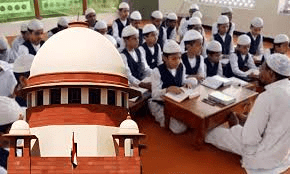
Why in news?
The Supreme Court of India (SC) has reserved its judgement regarding the constitutionality of the Uttar Pradesh (UP) Board of Madarsa Education Act, 2004. This ruling is crucial as it addresses significant issues concerning secularism, the right to education, and how religious education aligns with modern educational standards in India.
What is the UP Madarsa Education Act 2004?
- The Act regulates the educational activities in madarsas, which are institutions that provide religious education along with some secular subjects, albeit with a focus on religious teachings.
- It established the UP Board of Madarsa Education, primarily comprising members from the Muslim community, which is tasked with creating the curriculum and overseeing examinations for various madarsa courses, from 'Maulvi' (equivalent to Class 10) to 'Fazil' (equivalent to a Master’s degree).
Status of Madarsas in UP:
- Uttar Pradesh has the highest number of madarsas in India, with about 1.69 lakh students enrolled in over 14,000 recognized institutions, participating in board exams equivalent to Class 10 and Class 12 in 2023.
The Madarsa Education Act declared unconstitutional:
- In March 2024, the Allahabad High Court ruled the 2004 Act unconstitutional, mandating the integration of madarsa students into the mainstream education system.
- The SC temporarily stayed this ruling in April 2024 and commenced hearings in October, also halting notifications from the National Commission for the Protection of Child Rights (NCPCR) regarding inspections of madarsas and the inclusion of non-Muslim students.
On What Grounds Allahabad HC Declared Madarsa Act Unconstitutional:
- Violation of secularism: The HC emphasized that secularism entails equal treatment of all religions by the state. The madarsa curriculum was criticized for making Islamic education compulsory while relegating modern subjects to optional status, conflicting with the state's obligation to provide secular education.
- Violation of the right to education: The court stated that the Act infringed upon Article 21A of the Indian Constitution, which guarantees free and compulsory education to children aged six to fourteen. It pointed out that the education quality in madarsas fell short of the standards defined by the Right to Education (RTE) Act, 2009.
- Conflict with the UGC Act: The provisions of the Madarsa Act were found to be inconsistent with the University Grants Commission (UGC) Act, 1956, which limits degree conferral to recognized universities. Thus, the madarsa board's authority to grant degrees was deemed unconstitutional.
Key Arguments on the Constitutionality of the Madarsa Education Act Before the SC:
- Religious education vs. religious instruction: A central debate was whether madarsas provide "religious education," which is permitted, or "religious instruction," which is prohibited in state-funded institutions. The distinction is vital as Article 28 of the Constitution forbids religious instruction in such contexts.
- Striking down the entire Act: Another significant discussion revolved around whether the HC's decision to strike down the entire Act was appropriate or if only specific unconstitutional provisions should have been nullified. Chief Justice D.Y. Chandrachud pointed out that the state could regulate madarsa education to align with secular principles without entirely abolishing the Act.
Wider Implications of the SC's Decision on the Madarsa Education Act:
- The SC's decision is expected to have national consequences beyond UP, impacting the interaction between religious education and secularism.
- This case raises broader questions about the state's role in ensuring that all children, regardless of religious backgrounds, receive a modern, secular education.
- The ruling could also influence other religious educational institutions such as gurukuls and convent schools that blend religious teachings with their curricula.
- Chief Justice Chandrachud cautioned that the principles of secularism must be carefully considered when regulating religious instruction.
Conclusion:
- The upcoming judgement from the SC on this matter could establish a significant precedent for the future of religious education in India, potentially reshaping the coexistence of religious and secular education in the country's diverse educational framework.
|
59 videos|5388 docs|1140 tests
|
FAQs on UPSC Daily Current Affairs: 23rd October 2024 - Current Affairs & Hindu Analysis: Daily, Weekly & Monthly
| 1. What is the purpose of India's cloud chamber under Mission Mausam? |  |
| 2. What are the main focus areas of Mission Mausam? |  |
| 3. Which institutions are involved in the implementation of Mission Mausam? |  |
| 4. How does a cloud chamber function in the context of weather research? |  |
| 5. What significance does the study of convective clouds have for India? |  |
















